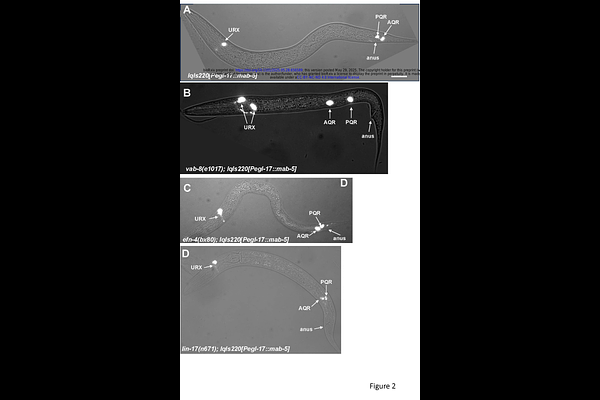VAB-8/KIF26, LIN-17/Frizzled, and EFN-4/Ephrin, control distinct stages of posterior neuroblast migration downstream of the MAB-5/Hox transcription factor in Caenorhabditis elegans

VAB-8/KIF26, LIN-17/Frizzled, and EFN-4/Ephrin, control distinct stages of posterior neuroblast migration downstream of the MAB-5/Hox transcription factor in Caenorhabditis elegans
Jain, V. D.; Lundquist, E. A.
AbstractHox transcription factors are involved in neuronal and neural crest development and differentiation, including migration, but the genetic programs employed by Hox genes to regulate terminal differentiation remain to be defined. In C. elegans, the Antennapedia-like Hox factor MAB-5 is both necessary and sufficient to induce posterior migration of the Q lineage neuroblasts and neurons downstream of canonical Wnt signaling. Q lineage fluorescence-activated cell sorting and RNA seq in mab-5 loss-of-function and gain-of-function backgrounds revealed genes with expression in the Q lineage dependent upon MAB-5. Here, the roles of three mab-5 target genes in QL lineage posterior migration are delineated, vab-8/KIF26, lin-17/Fz, and efn-4/Ephrin. First, live, time-lapse imaging of QL.a and QL.ap posterior migration revealed that this migration occurs in three distinct stages: QL.a migration posterior to QL.p; after QL.a division, posterior migration of QL.ap to a region immediately anterior to the anus; and final migration of QL.ap posterior to the anus to the final position where it differentiates into the PQR neuron. vab-8 affected each of the three stages, lin-17 affected stages two and three, and efn-4 was required for the third stage of posterior QL.ap migration. Thus, different MAB-5 target genes control distinct stages of posterior migration. mab-20/Semaphorin, a known interaction partner with efn-4, also affected only the third stage similar to efn-4. Suppression of mab-5 gof posterior migration confirmed that these genes act downstream of mab-5 in posterior migration. Possibly, VAB-8/KIF26 trafficks distinct molecules to the plasma membrane that mediate distinct stages of migration, including LIN-17/Fz and EFN-4. Surpisingly, failure of stages two and three led to the premature extension of a posterior dendritic protrusion, which normally forms after QL.ap had migrated to its final position and PQR differentiation begins. This suggests a link between migration and differentiation, where differentiation is delayed while migration proceeds. In sum, this works delineates a transcriptional program downstream of mab-5/Hox that controls posterior neuroblast migration, in response to Wnt signaling.